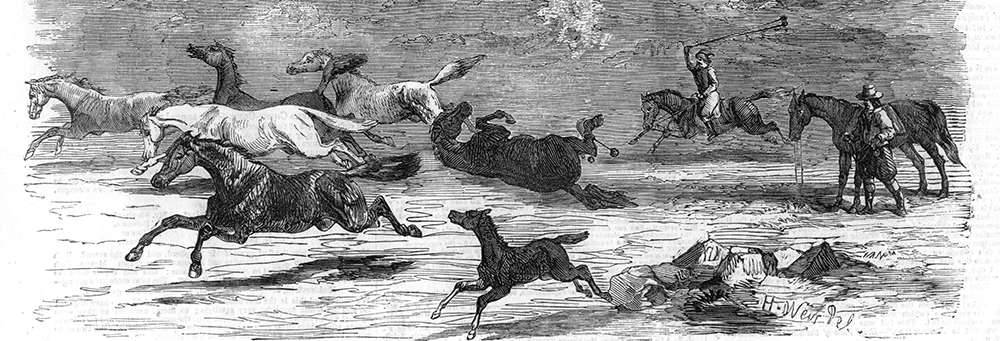The first horses arrived in the Falklands when the French brought them to their settlement at Port Louis in 1764. The Spanish taking over Port Louis, or Puerto Soledad as they named it in 1776, augmented the 6 horses the French had left with imported animals from the coast. By 1782 the horses there had multiplied to 50 and by 1778 there were 166 reportedly at Puerto Soledad. Whether the horses originated in France or came by way of South America they soon became wild, although they did not increase in numbers as did the wild cattle. By the 1840’s cattle, originally domestic and deposited at various points around the islands for the convenience of the penguin hunters and sealers during the 1700’s, had became wild and multiplied rapidly until they numbered thousands. Gauchos from Uruguay and Chile were recruited to work the cattle. They needed many horses. Vernet, relocating to the Falklands for cattle hunting, took horses from his cattle rearing estancia south of Río Salado to the Falklands. The first shipment (1824) had to be landed short of Port Louis as they were starving. 22 of these surviving horses were found again in 1826 when Vernet's second expedition arrived at Port Louis, they had thrived and were in fine health. The 1826 ship carried horses left over from his cattle slaughtering activities near Río Negro and were likely to be the best of good stock. Being used to hard plains these horses soon disabled on the soft land of the Falklands but Vernet persevered finding ways of training and using hunting horses to suit the terrain. By 1842 horses on East Falklands were estimated by Lieutenant John Tyssen, to number between two and three thousand head. Lieutenant Tyssen, (Naval officer-in -charge 1839- 1841) ‘devoted much attention to the subject’.
Lieutenant Governor Moody reports in his despatch Lord Stanley 14th April 1842 that:
‘The wild horses are always in good condition, with fine coats and clean limbs; but they are naturally a poor ugly breed, about 14 hands high, low shouldered, cat hammed, and with large coarse heads. This is the general character, but there are some very fair exceptions. The colts reared at the settlement turn out serviceable and hardy. It is generally supposed that they have but little stamina, but there can have been no fair means of judging whether they have or not, the treatment of them being such that few horses in the world could undergo it without giving way.’
Moody also stated that the wild horses were found on both sides of Berkeley Sound, but chiefly on the south side, between Port William and Port Louis, and never south of the Wickham Heights. This would seem to be borne out by Charles Darwin who while on a ‘riding excursion around the island’ in the company of two gauchos and six hired horses (March 1834) noted that although they saw a single troop of wild horses to the north of the hills, while they were south of the hills (Wickham Heights, Mount Pleasant and Mount Usborne area) ‘the best country for wild cattle’ he recorded that there were ‘no wild horses here, only cattle’, and commented that neither he nor the gauchos could explain why the wild horses chose to remain in the east of the islands. Two Sister mountains can be seen in the background of the 1856 illustration.
Mares were imported from Montevideo on the schooner Governor Moody in 1851.
In 1903 64 horses were imported from Patagonia.
    
|

 Gauchos catching wild horses in the Falkland Islands- Illustrated London News 1856
Gauchos catching wild horses in the Falkland Islands- Illustrated London News 1856